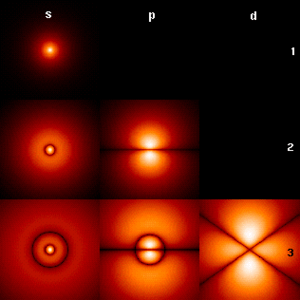Hydrogen atom facts for kids
A hydrogen atom is the smallest and simplest type of atom for the chemical element hydrogen. It is like a tiny building block of matter.
Every hydrogen atom has two main parts. At its center is a positively-charged nucleus. Circling around this nucleus is a single, negatively-charged electron. The electron is held close to the nucleus by a strong electric pull called the Coulomb force.
Most hydrogen atoms, called hydrogen-1 or protium, have a nucleus made of just one proton. Sometimes, the nucleus can also have one or more neutrons. When a hydrogen atom has neutrons, it becomes a different type of hydrogen called an isotope. For example, deuterium has one proton and one neutron, and tritium has one proton and two neutrons. Hydrogen-1 is the most common type of hydrogen found in nature.
Contents
What is a Hydrogen Atom?
A hydrogen atom is the basic unit of the element hydrogen. It is the most common atom in the universe. About 75% of all normal matter is hydrogen. This tiny atom is a key part of stars, water, and even living things.
Tiny Building Blocks: Protons, Neutrons, and Electrons
Every atom is made of even smaller particles. A hydrogen atom is special because it is so simple.
- Proton: This particle is found in the atom's center, called the nucleus. It has a positive electric charge. Most hydrogen atoms have only one proton.
- Neutron: These particles are also in the nucleus but have no electric charge. Some types of hydrogen atoms have neutrons.
- Electron: This particle moves around the nucleus. It has a negative electric charge. A hydrogen atom always has one electron.
The Power of Attraction: How Atoms Stay Together
The electron is not just floating around randomly. It is strongly attracted to the positively charged nucleus. This attraction is called the Coulomb force. It is an electric force, much like how magnets attract each other. This force keeps the electron "bound" to the nucleus, preventing it from flying away. It is what holds the atom together.
Different Kinds of Hydrogen: Isotopes
While all hydrogen atoms have one proton and one electron, they can differ in the number of neutrons. These different versions are called isotopes.
Protium: The Most Common Hydrogen
Protium is the most common type of hydrogen. It is also known as hydrogen-1 or "light hydrogen." Its nucleus contains only one proton and no neutrons. This is the hydrogen we usually think of when we talk about water (H₂O) or the gas that fills the sun.
Deuterium: Hydrogen with an Extra Neutron
Deuterium is another isotope of hydrogen. Its nucleus has one proton and one neutron. Because it has an extra neutron, it is about twice as heavy as protium. Deuterium is sometimes called "heavy hydrogen." It is found naturally in small amounts, especially in "heavy water," which is used in some nuclear power plants.
Tritium: The Rare Hydrogen
Tritium is a very rare isotope of hydrogen. Its nucleus contains one proton and two neutrons. This makes it even heavier than deuterium. Tritium is radioactive, meaning it slowly changes into another element over time. It is used in some specialized lighting and scientific research.
Why Hydrogen is Important
Hydrogen atoms are incredibly important for many reasons. They are the main fuel for stars like our Sun, powering them through nuclear reactions. On Earth, hydrogen is a key part of water, which is essential for all life. It is also found in almost all organic compounds, which are the building blocks of living things. Scientists are also exploring hydrogen as a clean fuel source for the future.
See also
 In Spanish: Átomo de hidrógeno para niños
In Spanish: Átomo de hidrógeno para niños


